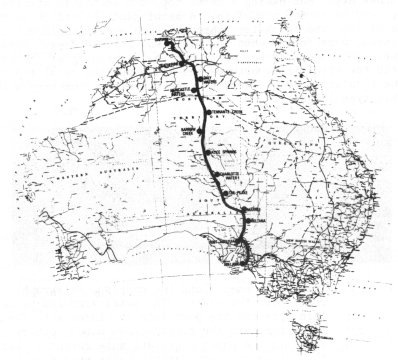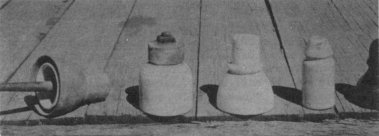The Australian Overland Telegraph Line
by Fred and Mary Sue Gifford
Reprinted from "INSULATORS - Crown Jewels of the Wire", December 1973, page 4
As has been the case in America, the early achievements of Postal engineers
and others in developing communications between the isolated communities of the
Commonwealth of Australia are fascinating and instructive to all interested in
the art of telecommunication. However, perhaps none is more interesting and
indicative of the tenacity and pertinacity of the Australian pioneers than that
of the establishment of the overland telegraph line between Port Augusta and
Port Darwin shortly after Australia had been crossed for the first time by John
McDonald Stuart in 1860-1862.
It was less than ten years later that a telegraph line had been completed
practically along the route taken by Stuart (Figure 1). Prior to this, however,
in the late 1860's, there was great rivalry between Queensland and South
Australia as to who should have the honor of linking their telegraph system with
the cable being laid from Singapore to Darwin. Each wanted the other Australian
colonies to support the project from their particular point of view. When in
June, 1870, no agreement had been arrived at and the Cable Company seemed to
favor the land line being constructed from Darwin (in the Northern Territory) to
Brisbane (in Queensland), the South Australian Government, evidently realizing
that some drastic action was necessary if they were to have the line in their
state, made an offer to the Cable Company to build a telegraph line from
Adelaide (in South Australia) to Darwin (1,975 miles). It was to be completed by
the time the Company had completed their cable, this being estimated at eighteen
months from the time of the offer. The offer, which meant that the telegraph
line had to be constructed at the rate of 110 miles per month, was accepted, and
heavy penalties for non-completion of the line in the time indicated were
provided for in the agreement. It was not until about the middle of August,
1870, that the construction was started. The Postmaster-General of South
Australia, Mr. Charles Todd (who was knighted in 1893), planned and supervised
the work.
|

|
| Figure 1 Map showing route of Australian overland telegraph, completed on
August 22, 1872. Rather harsh climatic conditions are indicated for the interior
in that all of the area inside the dotted line is classified as arid. |
The route was divided into three sections --- the lower section from Port
Augusta to 500 miles north was let by contract at approximately $103 per mile,
and the northern end from Darwin to about 650 miles south was let by contract at
prices varying from $155 to $222 per mile, the Government to provide in each
case wire and insulators. The central, and most difficult portion, was to be
constructed by the government. Each section was subdivided into many
subsections, and a party allotted to construct each subsection. A small
exploring party went ahead of each main party and marked out the route to be
taken. The equipment of each party included 15 horse wagons, 17 bullock drays (a
low wagon without sides), one bullock wagon, five express wagons, 165 horses,
and 200 bullocks.
A depot was established at the Finke River (about 830 miles north of
Adelaide) for the provision of fresh meat for the men working on the adjoining
sections, and 2000 sheep were sent there. It must be remembered that all the
material, provisions, etc., had to be hauled from either Port Augusta or Darwin
by horse, bullock vehicle, or camels, and some idea of the difficulties
experienced can be realized by the fact that it took Harvey's party, who
constructed one of the central sub-sections, eight months to reach the beginning
of their section.
It was far too big a job to be done in the specified time, and when the
period had expired (December, 1871), there were still many gaps in the line. A
delay had also occurred in the cable construction, and although not far off
completion, the cable was not completed on the contracted date. A compromise was reached
regarding the infliction of penalties, and the South Australian Government
redoubled its efforts. However, it was not until August 22, 1872, that the last
gap was closed and telegraphic communication was established between Australia
and England. The total cost of the line was approximately $1,200,000.
The original line was a 7/14 stranded iron wire conductor, specially
manufactured by Messrs. Johnson and Nephew (probably in Adelaide). Some years
later most of it was removed and replaced by a 400 lb. galvanized iron
conductor. In 1898 a 265 lb. copper wire was added to the route, and these two
wires were known as the Darwin Copper and the Darwin Iron. The copper carried
the high speed telegraph channel, and the iron the interstation telegraph
channel.
At least two types of insulators appear to have been used during initial
construction efforts. One type was of porcelain, about 4-1/2 inches across at
the bottom and 5-1/2 inches high, but having a metal top, two inches in
diameter, screwed on to the porcelain. A metal plate bolted on to the metal top,
and two holes, through which a wire could be passed, were formed when the plate
was screwed down. Apparently only one hole was used, but the tightening of the
bolt held the wire firmly between the plate and the metal top of the insulator.
There were thus no tie wires necessary with this type (Figure 2).
|

|
| Figure 2. Insulators used along the overland telegraph route over the years.
The metal armoured porcelain type and the porcelain insulator with the metal top
were the first styles used. Others shown in the photo represent more recent
styles, the "stovepipe hat" variety being used from probably the early
1900's and the others coming in as replacements from the early 1930's on. These
insulators were borrowed from the PostmasterGeneral's line depot in Alice
Springs, Northern Territory, for photographing. They will soon be given to the
Alice Springs Telegraph Station, which is now a museum and National Park. |
Another type of porcelain insulator was completely covered with a metal
armour. The metal armour is shaped exactly like the insulator, and the wire was
tied to this similarly as is done on present day insulators. The porcelain was
set into the armour by a kind of cement, and a thread was provided in the
porcelain for a metal spindle. The metal armour protected the insulator against
aborigines who would attempt to break them and use the porcelain for making
tools, points, etc. They also took the binding wires from insulators to make
fish hooks and, with some ingenuity, made tomahawks from the footplates taken
from iron poles. Presentations of fish hooks and tomahawks to the natives
overcame this particular problem. As was noted in a recent letter from Len
Hicks, line foreman for the Postmaster-General in Finke, Northern Territory, the
chances of finding any of the armour coated style in good condition now is
probably rather remote.
It is unfortunate that the records regarding original sources of the first
insulators used may have been lost. Inquiries to the Postmaster-General's Museum
in Adelaide, as well as reference to several books and also early issues of The
Telecommunication Journal of Australia, have failed to produce any useful
information. Apparently most of the porcelain insulators used during the past 20
or 30 years were made by Fowlers Potteries in New South Wales and Kosters
Pottery in South Australia (Adelaide), or simply imported.
In many instances the line did not take a direct route between various
points, but followed creeks and watercourses. The reason for this was that most
of the poles were cut from the timbers growing along these watercourses, and
also that it was necessary to follow the watercourses in order to obtain water.
However, termites insured that most of the wooden poles had very short lives,
perhaps only of a few years' duration. In 1880, re-poling with Siemens (Siemens
Brothers & Co., London) and Oppenheimer metal poles was commenced in places,
but it was not until 1898, when the 265 lb. copper conductor was added, that the
line was fully iron-poled. During the erection of the copper wire and the final
iron poles, the line route was considerably straightened, now following a more
direct route and not keeping to the watercourses.
Five men died during the construction of the lines, one from thirst, one from
consumption, another from fever, one was lost in the bush when looking for stray
horses, and one was drowned.
|
